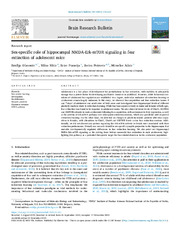Приказ основних података о документу
Sex-specific role of hippocampal NMDA-Erk-mTOR signaling in fear extinction of adolescent mice
| dc.creator | Glavonić, Emilija | |
| dc.creator | Mitić, Miloš | |
| dc.creator | Francija, Ester | |
| dc.creator | Petrović, Zorica | |
| dc.creator | Adžić, Miroslav | |
| dc.date.accessioned | 2022-12-05T09:27:55Z | |
| dc.date.available | 2022-12-05T09:27:55Z | |
| dc.date.issued | 2023 | |
| dc.identifier.issn | 0361-9230 | |
| dc.identifier.uri | https://vinar.vin.bg.ac.rs/handle/123456789/10514 | |
| dc.description.abstract | Adolescence is a key phase of development for perturbations in fear extinction, with inability to adequately manage fear a potent factor for developing psychiatric disorders in adulthood. However, while behavioral correlates of adolescent fear regulation are established to a degree, molecular mediators of extinction learning in adolescence remain largely unknown. In this study, we observed fear acquisition and fear extinction (across 4 and 7 days) of adolescent and adult mice of both sexes and investigated how hippocampal levels of different plasticity markers relate to extinction learning. While fear was acquired evenly in males and females of both ages, fear extinction was found to be impaired in adolescent males. We also observed lower levels of GluA1, GLUN2A and GLUN2B subunits in male adolescents following fear acquisition, with an increase in their expression, as well as the activity of Erk-mTOR pathway over subsequent extinction sessions, which was paralleled with improved extinction learning. On the other hand, we detected no changes in plasticity-related proteins after fear acquisition in females, with alterations in GluA1, GluA4 and GLUN2B levels across fear extinction sessions. Additionally, we did not discern any pattern regarding the Erk-mTOR activity in female mice associated with their extinction performance. Overall, our research identifies sex-specific synaptic properties in the hippocampus that underlie developmentally regulated differences in fear extinction learning. We also point out hippocampal NMDA-Erk-mTOR signaling as the driving force behind successful fear extinction in male adolescents, highlighting this pathway as a potential therapeutic target for fear-related disorders in the adolescent population. © 2022 The Authors | en |
| dc.relation | info:eu-repo/grantAgreement/MESTD/inst-2020/200017/RS// | |
| dc.rights | openAccess | |
| dc.rights.uri | https://creativecommons.org/licenses/by/4.0/ | |
| dc.source | Brain Research Bulletin | |
| dc.subject | Development | en |
| dc.subject | Fear-related learning | en |
| dc.subject | Glutamate receptors | en |
| dc.subject | MTOR pathway | en |
| dc.subject | Sex differences | en |
| dc.subject | Synaptic plasticity | en |
| dc.title | Sex-specific role of hippocampal NMDA-Erk-mTOR signaling in fear extinction of adolescent mice | en |
| dc.type | article | en |
| dc.rights.license | BY | |
| dc.citation.volume | 192 | |
| dc.citation.spage | 156 | |
| dc.citation.epage | 167 | |
| dc.identifier.doi | 10.1016/j.brainresbull.2022.11.011 | |
| dc.identifier.pmid | 36410566 | |
| dc.type.version | publishedVersion | |
| dc.identifier.scopus | 2-s2.0-85142731578 | |
| dc.identifier.fulltext | http://vinar.vin.bg.ac.rs/bitstream/id/27393/1-s2.0-S0361923022003197-main.pdf |
Документи
Овај документ се појављује у следећим колекцијама
-
090 - Laboratorija za molekularnu biologiju i endokrinologiju
Department of Molecular Biology and Endocrinology -
Radovi istraživača
Researchers' publications

